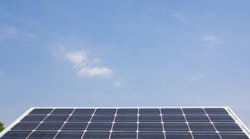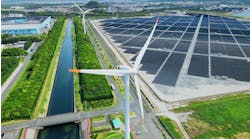Just over a year has passed since President Biden signed the landmark Inflation Reduction Act (IRA) into law, following the already significant Bipartisan Infrastructure Law (BIL, also known as Infrastructure Investment and Jobs Act) of 2021. Both dedicate funding to energy- and climate-related improvements. The IRA alone will allocate a projected $369 billion to climate change and efficiency initiatives over the next decade, and, according to modeling by the Electric Power Research Institute, could lead to a 40% reduction in economywide greenhouse gas emissions below 2005 levels by 2030.
The two laws cover a lot of ground and promise investments across many sectors. Because of the focus on carbon reduction and energy efficiency, the rollout of these sweeping initiatives is expected to boost investments in smart building technologies immediately.
A lot remains to be clarified about BIL and IRA, but the wheels are turning quickly. Funding is flowing, and private sector investments are moving forward in many areas. Both private and public entities are looking heavily at renewable power plants and generation, but addressing energy use and the increasingly electrified building stock—and fleet—is also important. Accelerating the move to smarter buildings and the technology needed to make it happen is a big part of the long-term strategy of decarbonization: Buildings are behind an astounding 74% of the country’s electricity use.
“Smart building technologies are key for optimizing energy use and electrical systems to ensure a building isn’t wasting resources,” says Ava Gallo, climate and energy manager at the National Caucus of Environmental Legislators. “These technologies are also vital to managing the stress on the grid due to a dramatic increase in electrification. Reliability, sustainability, and efficiency are all maximized by the use of smart technologies.”
Earlier this year, the Department of Energy (DOE) announced a plan to provide $1 billion for state and local governments to expand implementation of current building energy codes. For most residential and commercial buildings to comply with the new code, building controls will have to be part of the equation.
“As part of our R&D work, we are working to develop standardized control sequences that save energy and are easier to implement,” says Ram Narayanamurthy, deputy director of the Building Technologies Office (BTO) in DOE’s Office of Energy Efficiency and Renewable Energy. He expects the BIL-directed Resilient and Efficient Codes Implementation Program will lower electricity costs for families and businesses by upward of $138 billion over the next three decades.
Energy efforts
Energy is at the heart of the IRA, BIL, and President Biden’s climate agenda as a whole. About $76 billion of the BIL’s $550 billion funding package will be invested in energy programs, mostly through competitive grants. This builds on similar investments made during the 2009 American Recovery and Reinvestment Act. In August, DOE announced $46 million for 29 projects across 15 states to develop advanced building technologies and retrofit practices that reduce energy waste and enable healthier households and communities. Funding from the Buildings Energy Efficiency Frontiers and Innovation Technologies (BENEFIT) is intended to help advance cost-effective solutions to electrify buildings, improve energy efficiency, and increase demand flexibility. Focus and interest in making buildings and building technology smarter are growing.
The IRA also expands Internal Revenue Code Section 179D, the Commercial Buildings Energy-Efficiency Tax Deduction, which was originally instituted in 2006 to incentivize commercial and government buildings to reduce their energy usage. It has now been supercharged with more funds and a greater scope. According to DOE, 179D “enables building owners to claim a tax deduction for installing qualifying systems in buildings.”
The IRA expansion intends to drive private investment in the existing building stock. “While 179D has been around for a while, the IRA gave it more power,” says Rick Rodriguez, vice president of Energy & Performance Services at Siemens Smart Infrastructure USA. “It’s a tax deduction, not a tax credit, for building owners in certain markets that reduce their energy use in existing buildings per ASHRAE standards. The deductions had maxed out at about $1.88 per square foot previously, but now deductions are as high as $5 per square foot for projects put in service after Jan. 1, 2023. Today, almost all building types can take advantage of this.”
This tax incentive makes a compelling economic case to the business community and offers a true market incentive for the pursuit of energy efficiency. Data from the Environmental Protection Agency indicates that almost 30% of energy used in commercial buildings is wasted—leaving a lot of room for improvement.
“The biggest enemy of smart energy use isn’t coal or giant pickup trucks,” says David Nemtzow, senior adviser with the DOE’s Loan Programs Office and previous director of DOE’s BTO. “It’s apathy. The tax credits and DOE’s loans and other deployment programs are intended to encourage people to make conscious and aware decisions. That very much includes ‘smartness’ and controls for buildings.”
“The latest round of the IRA is very relevant to things like smart metering and building automation systems,” Rodriguez says. “That is one of the key enablers to reducing and controlling energy. The legislation has created a funding mechanism for buildings to pursue things like solar energy and battery storage, renewable energy, and car charging.”
Without smart monitoring and control systems in place, many building owners would find it difficult to hit the marks they need to earn those substantial tax breaks. Insulation and LED fixtures alone won’t do it. And for those seeking direct funding in the form of DOE loans or grants, going smart must be part of the equation.
“Since the passage of the IRA, the DOE Loan Programs Office has hundreds of billions of dollars in lending to help invest in energy projects,” explains Nemtzow, who reviews applications for such funding. “And we do require technical innovation, full stop, in most cases. Technical innovation is where the biggest impacts are in terms of energy efficiency and overall savings. I think that’s why we’re seeing so much interest from the buildings sector in our new financing.”
And innovation is skyrocketing. Emerging technology like artificial intelligence and machine learning are also generating new opportunities. “By leveraging technology, you can identify efficiencies within your assets, lower energy consumption, and optimize the use of technicians and service people that come to the site to perform services,” says Ben Dwyer, vice president of Digital Enterprise at Siemens Smart Infrastructure USA. “It’s a real holistic efficiency.”
Implementation in effect
While activity is happening on the ground already, legislation at the scale of BIL and IRA takes time to coordinate and roll out—as expected for large infrastructure bills. It’s a marathon, not a sprint, but the pace has been strong. “The framework is out there, even if some of the details are a little slow coming,” Dwyer says. “There's additional guidance being developed and still some education that's going on.”
For the next five years, funding for energy-related programs in DOE will triple. BIL and IRA are already creating jobs in clean energy and offering homeowners up to 30% in tax credits for what they spend on home energy efficiency improvements, which could translate into savings of $1,200 per year.
“We’re on our way and already seeing tremendous progress across the country,” Narayanamurthy says. “Overall, these are historic investments unmatched since DOE’s founding. It stands up 60 entirely new programs while expanding 12 existing ones. We’ll be overseeing this funding for a decade.”
At a state level, many legislators and other stakeholders are buoyed by the federal funding that can support local projects. However, a capacity gap between state energy agencies and the effort needed to apply for and receive funding can exist. Some climate-conscious legislators are facing barriers, both political and administrative.
“Overall, these are historic investments unmatched since DOE’s founding. It stands up 60 entirely new programs while expanding 12 existing ones. We’ll be overseeing this funding for a decade.”
“Many of the grants require matching funds, which can be a challenge for some states and municipalities to procure,” Gallo says. “And some states are refusing opportunities for funding through things like the Solar for All program within the Greenhouse Gas Reduction Fund and Climate Pollution Reduction grants.”
However, Gallo adds, several states are leaning in and getting creative about how they position themselves to best receive federal funds for these programs. Colorado recently passed legislation that has been called its own version of the IRA; it offers tax credits complementing those offered in the federal version to encourage consumers to electrify and decarbonize. Oregon has increased its state DOE funding by more than $3 million to offer assistance with applications and deadlines to environmental justice communities and tribes seeking IRA funding. New Hampshire is using a $3 million grant from the IRA to resurrect a sustainability action plan that has been dormant since 2009. Minnesota created and funded a statewide green bank that will maximize federal clean energy investments with the addition of private capital. Green banks are a big part of the overall nationwide effort, with some $20 billion expected to flow to such entities.
DOE’s BTO consults with the buildings industry to identify areas where research is needed most to advance state-of-the-art technologies. Many utilities also offer rebate programs to incentivize controls-based optimization of existing buildings.
“Several states are implementing smart-building investments,” Narayanamurthy says. “As more cities and states look to set energy performance requirements for their existing building stock, it could potentially enable more investment in smart building systems.”
“States are key in the implementation of both the IRA and the BIL,” Gallo says. “However, state legislators and agencies have far fewer resources than their counterparts on the federal level and need support to make the most of the federal funding, and thereby the emission reduction benefits. State legislators have the opportunity to positively influence where money flows, streamlining permitting and transmission, solidifying community solar programs, and establishing other policy options.”
Making action happen
While much of the work still lies ahead, some projects have already come to life as a result of the funding and aspirational marks established by the BIL and IRA. These projects give a glimpse of what we can expect to see in the coming years.
The multimillion Connected Communities program is one such example. “Nine pilot projects around the country are deploying new smart technologies in thousands of residential and commercial buildings,” Narayanamurthy says.
One project is a solar- and battery-powered microgrid housing community in Menifee, Calif. National homebuilder KB Home partnered with DOE, the University of California, Irvine, SunPower Corp., Schneider Electric, Southern California Edison, and Kia to create the all-electric community, which employs numerous smart building monitoring and controls technologies. Residents are expected to use 40% less energy than the national average.
The community microgrid will also test real-time solutions that support resiliency, such as bringing homeowners back online during a rolling blackout or extreme weather nearly instantaneously, with the aid of a charged electric vehicle. By 2030, grid-interactive, efficient buildings like those in Menifee could save up to $18 billion in power system costs and cut 80 million tons of carbon emissions annually, the DOE estimates.
The passage of BIL and IRA have given individuals and organizations concerned about the environment and climate change a lot to feel positive about.
Another example of a real-life project looking to capitalize on the incentives and investments in the BIL and IRA is happening in Bridgeport, Conn., where two K-12 schools are serving as demonstration sites for deep energy retrofits for the city’s 39 schools. The effort is supported through a collaborative effort that includes Siemens Industrial and several engaged statewide entities.
The retrofits include the implementation of new controls and building management systems, as well as the installation of new condensing boilers, heat pump water heaters, variable frequency drives, and energy-efficient lighting with controls. The schools will install solar and battery systems, and retro-commissioning of heating and cooling systems will improve energy efficiency and indoor air quality. These improvement measures will also add to the resiliency of the schools, which also serve as emergency shelters in the city’s underserved communities.
The passage of BIL and IRA have given individuals and organizations concerned about the environment and climate change a lot to feel positive about. To achieve the nation’s goals for decarbonization, control systems and smart technology will be front and center in these efforts.
“We have estimated for many years that we can improve performance of existing buildings by 10% to 15% through strategies such as recommissioning and retro-commissioning existing commercial buildings,” Narayanamurthy says. “As technologies mature and the grid becomes well quantified, more regulatory jurisdictions and mechanisms at the federal, state, and local level may begin to include smart building technologies.”
For more news, projects, and profiles in the smart buildings ecosystem, subscribe to the SBT newsletter and follow us on LinkedIn, X, and Facebook.



